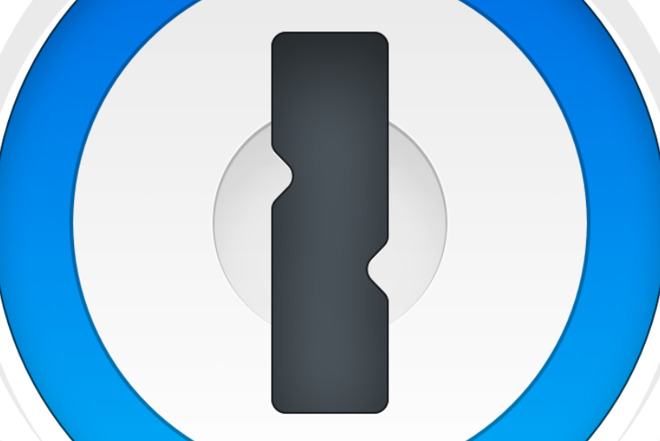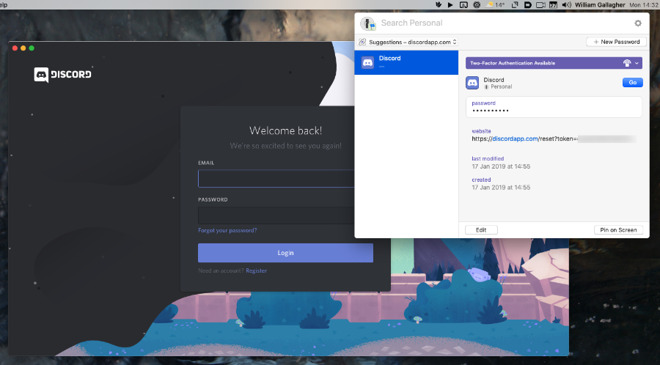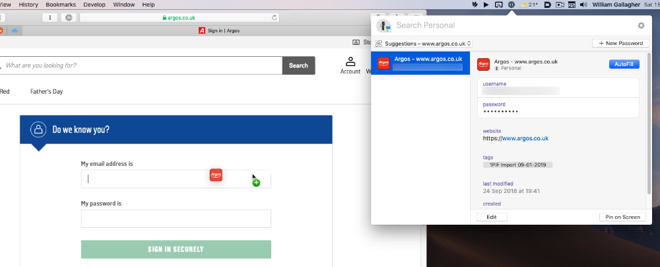Hands on: 1Password 7.3 for Mac recognizes apps and introduces drag and drop login
The latest version of password manager 1Password 7.3 concentrates on its Mac version's menubar app which now lets you drag passwords and login details into websites or also into supported apps on your Mac.

Password manager 1Password is a service and a series of apps for Mac, iOS, Windows and Android, which remembers your login details and also creates new, strong passwords as you need them. The newly updated 1Password 7.3 for Mac concentrates chiefly on its menubar companion app, 1Password Mini, which has been revamped for quicker access.
Previously, 1Password Mini was for use in websites and was only made a system-wide menubar app so that you could use it as easily with Safari, Chrome, Firefox or any other browser. Recently, though, the 1Password Mini app has been made useful within other apps.

We created an account on Discord's website but 1Password recognizes the app, too
In the previous version to this, 1Password Mini gained the ability to fill in your login details for apps such as ones in the Adobe Creative Cloud range. Now it's added others including those from the Omni Group. If you are in an app such as the OmniFocus To Do one, and you press the keystroke to launch 1Password Mini, it recognizes where you are and offers you relevant details.
Whereas with Apple's Keychain, you might have the login details for the app from when you signed up on its website, but getting those out into the app itself is a chore. Now 1Password 7.3 offers you the right login details for an app automatically.
Logging into an app or website will always be fastest using 1Password Mini and keystrokes because it automatically fills in the details. However, not all websites play nice with password managers and both to deal with them and just to give you another way of doing it, you can now drag login details from 1Password Mini and drop them onto the site or app.

You can now drag a login straight from 1Password's menubar app into a website
It would be good if you could drag both username and password at the same time, but this feature is especially useful when you have multiple accounts on the same service and 1Password can't know which one you need now.
This intelligent selection of what you're most likely to want appears to be done every time you open 1Password Mini, however. In the majority of cases that's going to be right, but previously if you went right back into 1Password Mini, it would open to the list of logins you last saw. That is sometimes more convenient if you're working through a series of logins.
To mitigate that, the new 1Password Mini app adds the ability to search tags. The main 1Password 7.3 app lists tags in a similar way to macOS Mojave's Finder windows, a sometimes endless column of them. So the fact that a regular search in the Mini app will now also find tags is useful.
The company now sells 1Password as a subscription service with different tiers and combinations. For an individual, you can have 1Password for Mac, iOS, Android and PC for $2.99 per month. Or you can use various family and teams tiers which let you share passwords in a group.

Password manager 1Password is a service and a series of apps for Mac, iOS, Windows and Android, which remembers your login details and also creates new, strong passwords as you need them. The newly updated 1Password 7.3 for Mac concentrates chiefly on its menubar companion app, 1Password Mini, which has been revamped for quicker access.
Previously, 1Password Mini was for use in websites and was only made a system-wide menubar app so that you could use it as easily with Safari, Chrome, Firefox or any other browser. Recently, though, the 1Password Mini app has been made useful within other apps.

We created an account on Discord's website but 1Password recognizes the app, too
In the previous version to this, 1Password Mini gained the ability to fill in your login details for apps such as ones in the Adobe Creative Cloud range. Now it's added others including those from the Omni Group. If you are in an app such as the OmniFocus To Do one, and you press the keystroke to launch 1Password Mini, it recognizes where you are and offers you relevant details.
Whereas with Apple's Keychain, you might have the login details for the app from when you signed up on its website, but getting those out into the app itself is a chore. Now 1Password 7.3 offers you the right login details for an app automatically.
Logging into an app or website will always be fastest using 1Password Mini and keystrokes because it automatically fills in the details. However, not all websites play nice with password managers and both to deal with them and just to give you another way of doing it, you can now drag login details from 1Password Mini and drop them onto the site or app.

You can now drag a login straight from 1Password's menubar app into a website
It would be good if you could drag both username and password at the same time, but this feature is especially useful when you have multiple accounts on the same service and 1Password can't know which one you need now.
This intelligent selection of what you're most likely to want appears to be done every time you open 1Password Mini, however. In the majority of cases that's going to be right, but previously if you went right back into 1Password Mini, it would open to the list of logins you last saw. That is sometimes more convenient if you're working through a series of logins.
To mitigate that, the new 1Password Mini app adds the ability to search tags. The main 1Password 7.3 app lists tags in a similar way to macOS Mojave's Finder windows, a sometimes endless column of them. So the fact that a regular search in the Mini app will now also find tags is useful.
The company now sells 1Password as a subscription service with different tiers and combinations. For an individual, you can have 1Password for Mac, iOS, Android and PC for $2.99 per month. Or you can use various family and teams tiers which let you share passwords in a group.

Comments
I wish it would coordinate better with Keychain though. Up until Apple allowed password managers to better integrate with iOS I was using keychain more often simply because it worked so much better with my iPad and iPhone. Now I essentially have 2 parallel password files.
For example, keeping a detailed list of a tetanus/diphtheria/pertussis shot, which will remind me when 10 years is about to expire. I've made my own detailed system in the Secure Notes section, but a pre-set category would made this easier.
I'd also like to be able to move Sections around, not just the label and items within a section. I buy add new vehicles and other pertinent data in Secure Notes that require listed a lot of detail, but they keep being placed below one another further down which adds time to find the newer items. Not a huge deal, but still a level of inconvenience, and breaking them all out individually for that Secure Note would clutter up that section too much.
I'm fine with it and it's now less costly for me at $1 per month. As the one that has to deal with everyone's technical issues anyway, I created a family account and have put pretty much everyone on my family plan. I have them send me $12 for the year via Apple Pay Cash and help them set it up. It's also easier for me to reset their master password remotely if they forget 🤦♂️ and to have shared vaults for the items that are used between one of more family members. I remember it being a bit overwhelming when I first started using 1P, but Keychain was (and is) far too anemic for my needs.
My system was to have to input a single name, username, and password for a website or app per day. This prevents them from being overwhelmed by that initial and helps establish facilities with the app. After that is effectively complete, then it's changing a single password per day to something complex and secure using their password generator. After that it's cleaning up a single login entry per day with stuff like attached email, credit card, etc. as noted in the accounts settings section of the app, as well, as secret questions and answers, and other data that could be pertinent in the login entry or other areas of the app, like added credit card and bank account data. Optional items for the more intrepid are cleaning up the URL that is auto-added, but that's more for visual effect, or wireless router access details, as well as the .config download as seen in AIrPort routers.
I subscribe to a number of what I consider mission critical apps and 1Password 7 is one of them, along with Office 365 and Quicken.
I'm not completely free from syncing to my.1password.com, but it's only used for a handful of shared logins which are mostly comprised of my family's streaming media logins, not anything that needs the highest level of security.
Fact is, they never owned it. If they’d bothered to read the license then they’d know that they bought a license to use it, not own it. The difference being that they can’t sell the package on.
When software cost £400 a pop, they complained. Now it costs a few quid a month, they still complain.
Well, developers have to eat, so if they’re happy to pay full price on each upgrade, then that can work.
I don't mind upgrading my software when I'm ready and I like having the option to skip a version that doesn't offer anything I'm interested in. But subscriptions take both of those options away. Some things I don't mind subscribing to and some I do.
edit: I also think that when some people say they want to own their software they mean they want to pay for it one time. “Own” is just a simpler way of saying that.
And while I understand that developers have to eat, I also don’t think that’s my responsibility. Developers should be making and upgrading (if they so choose) a product I want to pay for. In most cases I’m not interested in a product that will stop working if I stop paying. I like to pay once and be done. This can be said for many things, not just software.
https://discussions.agilebits.com/discussion/comment/451616/#Comment_451616
Just SAY NO to subscriptions!
1. The keychain now takes care of the needs of 95+ percent of users. It’s really great and the seamless sync is a really huge advantage of the Apple ecosystem over the Android/Windows ecosystem.
2. If you do need something more than what keychain offers, 1Password is unquestionably the best one (don’t take my word for it, Wired just came to the same conclusion).
3. Subscriptions don’t bother me, because I’m selective about them and audit my use of subscription software at least twice a year. If AgileBits still had a purchase model, you’d be paying $50/year or thereabouts to stay up-to-date on the app ... under the subscription model, you get more support and pay ... $36 for an individual license. If you need family vaults, the $5/month tier looks like a stone-cold bargain to me ... $60/year on sub vs $50 let’s say every two years for four family members? That’s a no-brainer.
4. Having dealt with the staff on a few occasions, I like that they’re in Canada rather than the US, and I’ve had an unrelentingly positive and pleasant experience, including a nice chat when 7 first came out helping me decide which way to go with my upgrade (they still offered purchase at the time). So that’s important.
Bottom line: if you have a friend or relative that’s not a nerd but has Apple stuff, teach them how to use the built-in keychain tools in Safari, and how to look up passwords in Accounts and Passwords/Keychain Assistant for reassurance. They won’t need to, but I find it makes people feel a lot better.
If you have a need to have a password manager beyond keychain for the purposes of family/business/other features, 1Password is extremely well-supported and inexpensive for what you get (particularly on the family tier). Take a look at the other ones (LastPass, Dashlane, etc) too.